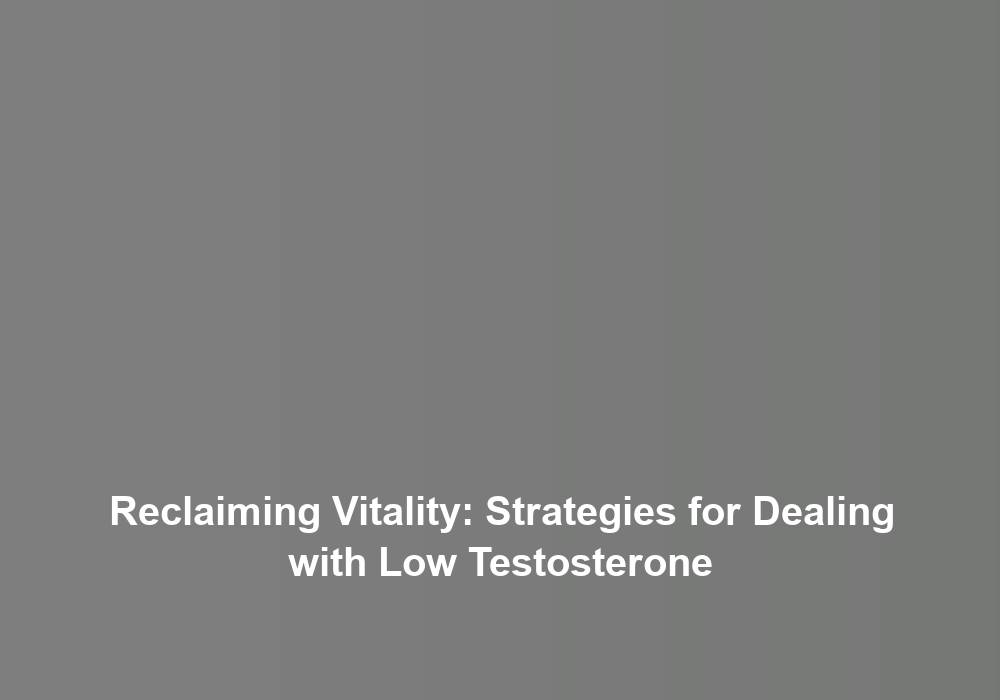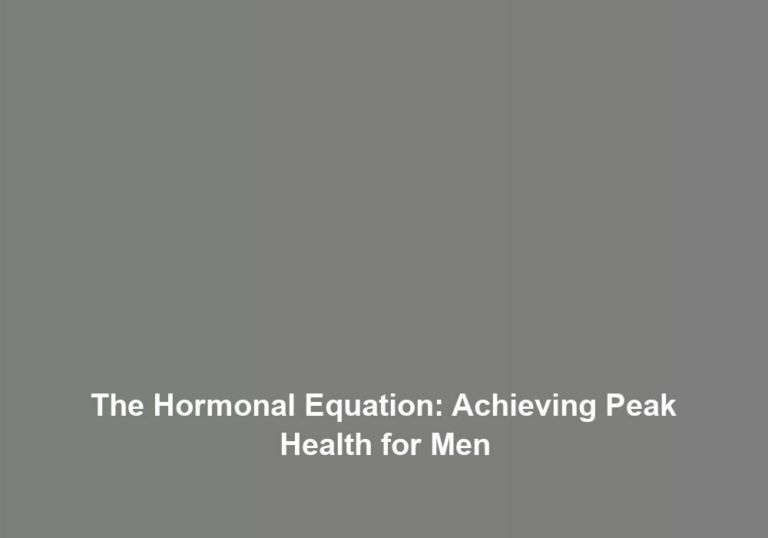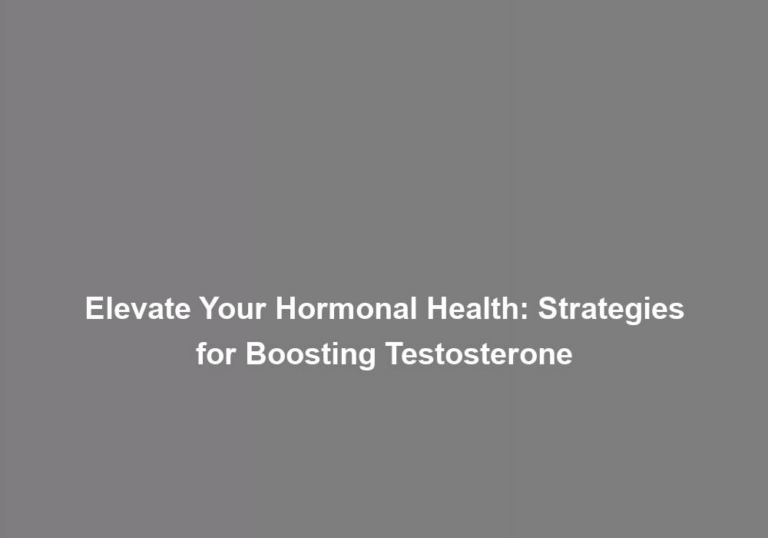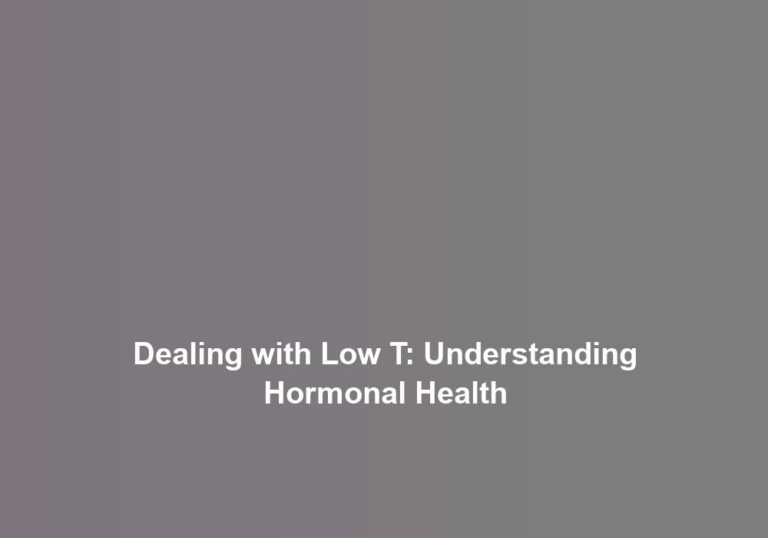Reclaiming Vitality: Strategies for Dealing with Low Testosterone
If youG??re feeling fatigued, irritable, and lacking in motivation, youG??re not alone. In fact, according to the Urology Care Foundation, an estimated 4 out of 10 men over the age of 45 have low testosterone. But before you dismiss these symptoms as just a normal part of aging, itG??s important to consider the impact of low testosterone and the strategies available to address it. From lifestyle changes to medical treatments, there are numerous options to help you reclaim your vitality and overall well-being.
Understanding Low Testosterone
Understanding low testosterone begins with recognizing the various symptoms and potential causes that may indicate its presence in your body. Hormonal imbalance can lead to reduced testosterone production, resulting in a range of symptoms, such as decreased energy levels, reduced muscle mass, increased body fat, and changes in mood. ItG??s essential to pay attention to these signs and seek medical advice to determine if low testosterone is the underlying cause.
Testosterone production is a complex process controlled by the brain and the endocrine system. Several factors can disrupt this delicate balance, including age, chronic illness, obesity, and certain medications. By understanding the potential causes of low testosterone, you can work with healthcare professionals to address the root of the issue and develop a personalized treatment plan.
ItG??s important to recognize that hormonal imbalance is not uncommon and seeking help is a proactive step towards reclaiming your vitality. Knowing that you are not alone in dealing with low testosterone can provide a sense of belonging and support as you navigate this journey. With the right guidance and support, it is possible to address low testosterone and its effects, allowing you to reclaim your energy, strength, and overall well-being.
Lifestyle Changes for Boosting Testosterone
To naturally boost testosterone levels, incorporating regular physical exercise into your routine has been shown to be an effective strategy. Engaging in both aerobic and resistance training exercise routines has been linked to increased testosterone levels. Aerobic exercises such as running, swimming, or cycling can help reduce body fat, which in turn can help to increase testosterone levels. On the other hand, resistance training, such as lifting weights or bodyweight exercises, can have a direct impact on stimulating the production of testosterone. Aim for at least 150 minutes of moderate aerobic activity or 75 minutes of vigorous aerobic activity per week, along with two or more days of strength training.
In addition to exercise, managing stress is crucial for maintaining healthy testosterone levels. Chronic stress can lead to elevated levels of cortisol, a stress hormone that can suppress the production of testosterone. Stress management techniques such as mindfulness meditation, deep breathing exercises, and yoga have been shown to reduce cortisol levels and support healthy testosterone production. Prioritizing adequate sleep, maintaining a healthy diet, and avoiding excessive alcohol consumption are also important factors in managing stress and supporting optimal testosterone levels.
Incorporating these lifestyle changes into your daily routine can help boost testosterone levels naturally. By adopting regular exercise routines and implementing stress management strategies, you can take proactive steps toward reclaiming vitality and optimizing your overall health.
Dietary Strategies for Increasing Testosterone Levels
Incorporate specific dietary adjustments to support healthy testosterone levels, focusing on consuming nutrient-dense foods and maintaining a balanced intake of essential nutrients. Research suggests that certain dietary strategies can help increase testosterone levels naturally. By incorporating the following dietary adjustments into your routine, you can optimize your nutrition to support healthy testosterone levels.
-
Nutrient-Dense Foods: Prioritize consuming foods that are rich in essential nutrients such as zinc, vitamin D, and omega-3 fatty acids. These nutrients play crucial roles in testosterone production and overall hormonal balance. Foods like lean meats, fish, eggs, nuts, seeds, and leafy green vegetables can provide essential nutrients that support healthy testosterone levels.
-
Balanced Macronutrient Intake: Ensure that your diet includes a balanced intake of carbohydrates, proteins, and fats. Consuming an appropriate amount of healthy fats from sources like avocados, olive oil, and fatty fish can positively impact testosterone levels. Additionally, maintaining a balanced intake of proteins and carbohydrates can further support hormonal balance and overall health.
-
Nutritional Supplements: Consider incorporating specific nutritional supplements into your diet to support healthy testosterone levels. Supplements such as vitamin D, zinc, and omega-3 fatty acids have been shown to have a positive impact on testosterone production. However, itG??s important to consult with a healthcare professional before adding any new supplements to your routine, as individual needs may vary.
Incorporating these dietary strategies, along with regular exercise routines, can play a significant role in naturally supporting healthy testosterone levels. Remember to prioritize nutrient-dense foods, maintain a balanced macronutrient intake, and consider the potential benefits of specific nutritional supplements to optimize your dietary approach for healthy testosterone levels.
Medical Treatments for Low Testosterone
While dietary strategies play a crucial role in supporting healthy testosterone levels, medical treatments for low testosterone offer additional targeted interventions to address this hormonal imbalance. Testosterone replacement therapy (TRT) is a common medical treatment for low testosterone. It involves the administration of testosterone into the body through various methods, such as injections, patches, gels, or pellets. Testosterone injections are a popular form of TRT due to their effectiveness and ease of administration.
| Type of Treatment | Description |
|---|---|
| Testosterone Replacement Therapy (TRT) | Involves the administration of testosterone into the body through various methods, such as injections, patches, gels, or pellets. |
| Testosterone Injections | Direct injection of testosterone into the muscle, typically performed every 1-2 weeks. |
Testosterone injections are typically administered into the muscle, and the frequency of administration varies based on the individualG??s needs, often ranging from every 1-2 weeks. This method provides a consistent and controlled release of testosterone into the bloodstream, helping to alleviate symptoms associated with low testosterone levels. It is important to note that TRT should only be administered under the supervision of a healthcare professional, as misuse or improper dosages can lead to adverse effects.
Hormone Replacement Therapy Options
When considering hormone replacement therapy options, it is essential to consult with a healthcare professional to determine the most suitable treatment for your specific needs. Hormone replacement therapy (HRT) can effectively address low testosterone levels and improve symptoms, but it is crucial to understand the available options and their potential effects on your health.
Hormone Replacement Therapy Options:
-
Testosterone Injections: These injections are administered every 2-4 weeks and can quickly elevate testosterone levels. However, they may cause fluctuations in mood and energy levels, and there is a risk of scar tissue at the injection site.
-
Transdermal Testosterone: This method involves applying a gel, patch, or cream directly to the skin, allowing for a steady release of testosterone into the bloodstream. It is less invasive than injections but may cause skin irritation or transfer to others through skin contact.
-
Natural Alternatives: Some individuals prefer natural methods for increasing testosterone levels, such as dietary changes, exercise, and herbal supplements. While these options may offer benefits, their effectiveness and safety can vary widely, and consulting with a healthcare professional is essential to ensure they are appropriate for your specific situation.
ItG??s crucial to be aware of potential side effects associated with hormone replacement therapy, such as acne, fluid retention, and an increased risk of cardiovascular issues. Your healthcare provider can help you weigh the benefits and risks of each option to make an informed decision that aligns with your overall health and well-being.
Conclusion
In conclusion, reclaiming vitality is within your reach. By making lifestyle changes, adjusting your diet, and exploring medical treatments, you can boost your testosterone levels and regain your energy and vitality. With the right strategies in place, you can revitalize your body and feel like your best self again. DonG??t let low testosterone hold you back – take charge of your health and reclaim your vitality today.







